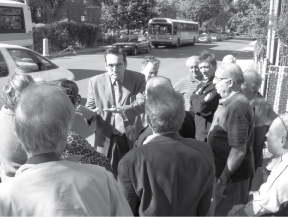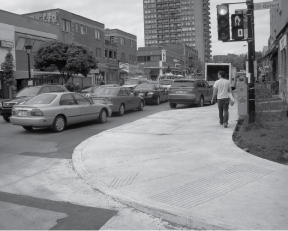With a municipal election only months away, anti-car policies are being forced on citizens, notably in the borough of Côte-des-Neiges-NDG, where merchants are left scratching their heads.
The trendy Monkland Village commercial district has been hit hard with anti-car measures in the past couple of months. Merchants say they feel powerless and frustrated in dealing with a borough administration that doesn’t take their viewpoints into consideration. Over the past few weeks, more parking spaces were removed on Monkland Ave. in favour of large, round concrete sidewalk extensions; some business-owners had no clue what was going on until the shovels hit the ground.
 “This is symptomatic of the waste and idiocy of this city,” said Allan Lazar, who owns a 30-year-old service station on Monkland. “There’s no logic. Why are they fixing what isn’t broken? It’s the same kind of mentality that led to the bike path on de Maisonneuve Blvd. Why spend so much money on infrastructure that isn’t needed?”
“This is symptomatic of the waste and idiocy of this city,” said Allan Lazar, who owns a 30-year-old service station on Monkland. “There’s no logic. Why are they fixing what isn’t broken? It’s the same kind of mentality that led to the bike path on de Maisonneuve Blvd. Why spend so much money on infrastructure that isn’t needed?”
Many other businesspeople wonder why the borough would proceed with a second round of sidewalk extensions. Five years ago, extensions were installed on Monkland and last year, spots were taken away in favour of yellow paint at every corner in an effort to slow down traffic and improve pedestrian safety.
“They’re making our lives as difficult as possible. No one ever consults the merchants,” said George Krausz, owner of the Buzz clothing boutique. “This is a commercial area. There should be parking. I pay $9,000 in taxes and have zero say.”
Monica Turcotte said it’s unacceptable that another parking spot was taken away in front of her shoe repair shop; also frustrating was that she was not made aware of the sidewalk enlargement project.
“We arrived that Monday morning and saw orange paint on the road, but had no idea what they were doing,” Turcotte said, questioning the removal of yet more spots and lamenting the concrete slab in front of her store. “If they would have put a bench with trees, it would have been something. This is just cement. I think it’s stupid.”
“What are they doing to encourage business to come to this street instead of being a deterrent? What is the city going to do for us?” asked Dany Roseman, head of the Monkland Merchants Association and owner of the Ciel Bleu boutique. On the occasions that his organization has been consulted about public works projects, he got impression that the chats were strictly a courtesy call. “I go to these meetings just to find out what is going to be done to us.”
 Borough mayor Michael Applebaum has been mum in the past few weeks on the outrage felt by merchants as drivers, through increasingly invasive infrastructure, are coerced into leave their cars at home in favour of public transit or a bicycle. In his stead, outgoing NDG councillor Marcel Tremblay defended the city’s transport plan and apologized to merchants who were taken by surprise by the construction work.
Borough mayor Michael Applebaum has been mum in the past few weeks on the outrage felt by merchants as drivers, through increasingly invasive infrastructure, are coerced into leave their cars at home in favour of public transit or a bicycle. In his stead, outgoing NDG councillor Marcel Tremblay defended the city’s transport plan and apologized to merchants who were taken by surprise by the construction work.
“Citizens are very happy with this because it permits them to walk safely on Monkland. We’re trying to create an atmosphere with fewer cars and more people walking,” Tremblay said. Regarding communication issues with business-owners: “On that aspect, we missed. They should have been informed.”
Homeowners and merchants alike were wondering earlier this month just “what was Applebaum smoking,” when the borough began eliminating parking spots in other areas in the borough, in favour of bike paths.
That’s what Ian Morantz, owner of Snowdon Deli, asked as he was trying to explain the sudden lack of parking space to his customers on Isabella Ave. at Decarie Blvd., outside his 63-year-old restaurant. What makes the decision so curious is that borough politicians and civil servants work directly across the street and often dine at the deli. Strange, area merchants say, that they didn’t foresee the consequences of their actions.
“I was shocked,” said Dave Spence, owner of Flex Nutrition on Decarie and Isabella. On May 29, he drove into work as he has been doing since 2002, “turned the corner and saw the ‘no-stopping’ signs. There’s no parking around here as it is. Customers won’t want to do business with you if there are no spaces.”
The borough had held public consultations on its bike plan, which was conceived with the help of Vélo Quebec, but didn’t go out of their way to publicize it. All the Decarie/Isabella merchants The Métropolitain spoke with said they never received an invitation to any such meeting. On May 28, Applebaum said no spaces on Isabella would be sacrificed. The very next day, no-stopping signs were posted, confusing merchants and customers alike.
Morantz collected 500 signatures on a petition in the first 48 hours alone, in support of the restoration of all spots on Isabella. Morantz said he’s seen a slight reduction in business due to the new rules; Spence said there was a noticeable decline. Optometrists, notaries and others along the two-block stretch of Decarie complained it would be impossible for their clients to continue to use their services if the bike path were placed in a prime parking area.
“The city is promoting the use of public transit and active transport,” said councillor Marvin Rotrand, who represents the Snowdon district. “There has been increased investment in augmenting metro and bus service and the extension of the network of bike lanes.”
Rotrand said the decision to put the path on Isabella was taken by centre-city. The executive committee member responsible for urban planning and transport is André Lavallée, who was recently pictured with Applebaum inaugurating the borough’s new 12.4 km worth of paths. Fielding Ave. is among those who also saw parking spots taken away for the special lanes and residents there were just as displeased with the decision.
Earlier this month, about a dozen irate homeowners met with borough director Stéphane Plante and communications director Michel Therrien on the corner of Fielding and Cavendish Blvd. In terms of both safety and logistics, that path is also a horrible idea, the residents said.
“It’s very dangerous here. A girl died a few years ago,” said Guy Duchesne, who lives on Fielding. “I would never put a bike path here. It’s fast enough with car traffic. They’re putting kids in danger.”
Dushesne was among the residents who Plante tried his best to calm, saying that the borough would look at a compromise. He also pointed out that the decision was a political one and civil servants were only following orders. Parking was eliminated on both sides of Fielding between West Broadway Ave. and Cote St. Luc Rd.
“If you want to have a debate on bike paths, it’s not with me that you should be speaking with,” Plante told residents, in lieu of Applebaum. “The validity of bike paths as a debate has been thrown out there. We are confident that a solution can be found.”
Spots were restored on Isabella just over one week after they were taken away. The prospect of a total reversal in policy is less likely for Fielding residents.
The lanes do not resemble the de Maisonneuve Blvd. route, which is separated from car traffic by a concrete median. In some cases, the only way a driver or cyclist can tell that they’re on a “bike path” is if they see a logo spray-painted on the road every few metres. The route on Terrebonne Ave., for example, has no other safety measure in place; no solid lines nor any traffic-calming poles to separate cyclists from motorists.
“That’s how it works in a lot of areas in Montreal,” Applebaum said. “It’s just like reserved bus lanes. If it is painted there, it’s because it’s respecting the norms that permit a bicycle and also a car to circulate.”
Sticking to centre-city norms and policies just won’t cut it for some irate residents who don’t understand why cyclists are being given special treatment by the city.
“How are my tenants going to unload their groceries?” asked Roco Domenico, who has lived on Fielding since 1974, and now can’t park anywhere around his home. “$5,000 in taxes! This doesn’t allow me to stop in front of my home?”

























Comments
Please login to post comments.